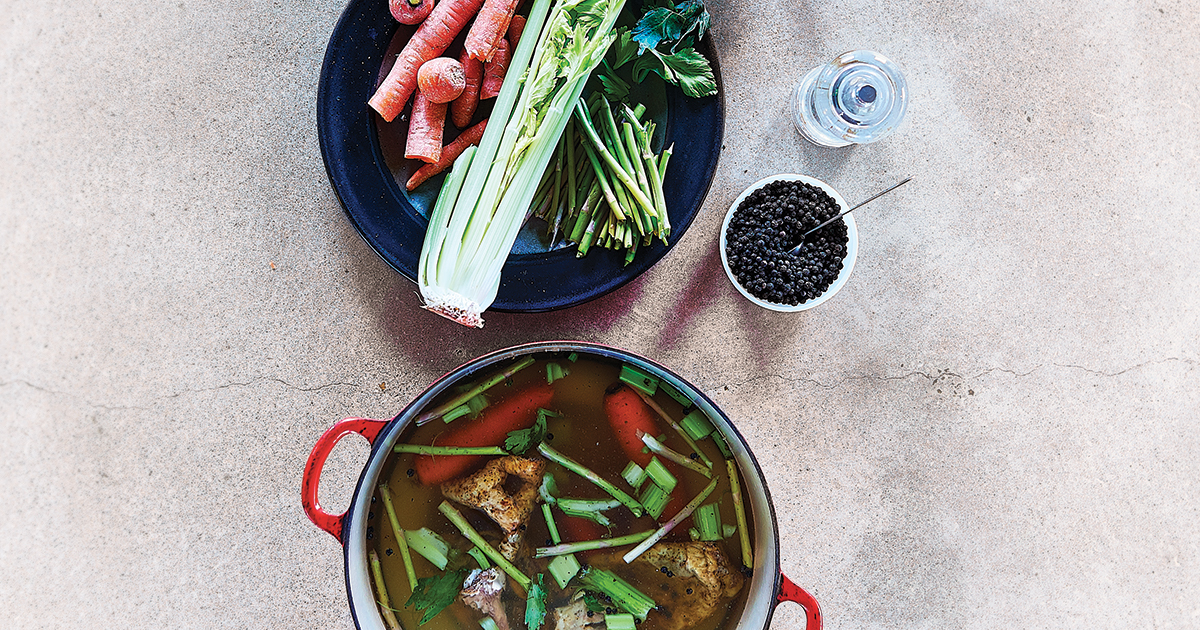In the late ’70s, I took a three-month break from my gig as the chef of a small restaurant in Boston to do an apprenticeship at a one-star restaurant in Chartres, France. The chef-owner, a renowned, old-school type, was a little long in the tooth but ran an elegant restaurant serving superb food. Every meal began with an amuse-bouche—a surefire, one-bite appetizer that delighted diners’ taste buds.
Monsieur Le Chef referred to this appetizer as pizza. (“Pee-za” is the way he pronounced it.) In fact, it was a tartlet lined with pie crust. Most remarkable were the ingredients in the crust, namely a mash-up of just about any of the leftovers from the day before: sweetbreads, fish fillet, rabbit, blanched cauliflower, tomatoes. No rhyme or reason, just leftovers. The items that did not get included in the little pizzas were destined for our staff meal. (I ended up becoming quite fond of rabbit livers.)
When I returned to Boston, the food costs where I worked dropped significantly, because I now thought like a French chef: Liberté, Egalité, Frugalité. No wasting food. My laudably ecological consciousness, however, went bye-bye when I left restaurants. I next worked in test kitchens and executive dining rooms, where there was little pressure to keep food costs down. Likewise, at home we often discarded spoiled food because I was too busy working full time and raising a family to do anything productive with our leftovers.
In that way, our little household, unfortunately, became part of a huge global problem: food waste. It is truly mind-boggling to realize that one-third of all the food produced worldwide is never used. And 90 percent of that wasted food ends up in landfills, the largest source of methane emissions—a prime contributor to global warming. Food is not all that is wasted. Money is, too. A family of four throws away between $1,350 and $2,275 annually.
Of course, individual families are hardly the only ones responsible for the problem. An engaging documentary released last year, titled “Wasted,” depicts how the farming, supermarket, and restaurant industries all contribute to the issue.
Happily, there is plenty each of us can do to limit waste. Specifically, plan meals and write a list before you go to the store, and only buy as much as you need. Check out the website www.makedirtnotwaste.org, which is full of strategies for prolonging the shelf life of various items.
My own advice is to start by trusting your nose. Even if the package declares an item is past its “use by” or “best by” date, give it a whiff. If it doesn’t smell spoiled, cook it; then freeze and label it for later.
Finally, if you have a backyard, consider starting a compost heap. The EPA website, www.epa.gov, has helpful, easy information on how to start composting at home.
It’s never too late. Vive La Frugalité.
Soup’s On
COMBINE any cooked ingredients with broth. Then thicken, if desired, with leftover mashed potatoes, pureed vegetables, or beans. Add some scrappy Parmesan rind for a bomb of umami flavor.
Top It Up
SAUTÉ those ragamuffin tops of beets, turnips, carrots, and radishes in olive oil; add a squeeze of lemon and some salt and pepper; and enjoy. Check out “Root-to-Stalk Cooking” by Tara Duggan.
Meat Makeover
FINELY CHOP cooked pork, lamb, or beef in a food processor; combine with an egg, breadcrumbs, pureed vegetables, or cheese; and form into burgers. Or shred meat and toss with barbecue sauce for a hearty sandwich.
Save the Scraps
FREEZE leftover cooked chicken bones and vegetable scraps and simmer into stocks later.
Patty Cake
MIX cooked, flaked fish with leftover mashed potatoes; pat into small cakes; and fry gently in oil.
For Moulton’s burger recipe using leftover cooked meat as well as a mac and cheese dish using cheese nubbins, see below.
Odd Lots Mac and Cheese
I don’t know about you, but my fridge tends to fill up with odd assortments of small chunks of cheese: a leftover bit of brie, some blue cheese bought for guests a week earlier, an end piece of cream cheese used for bagels last Sunday, a slice of mozzarella that didn’t make it onto a sandwich. You don’t want to toss them, but you can’t figure out how to use them.
Recently, I had an aha! moment: Why not throw them all together into a big pot of mac and cheese? Most cheeses play very nicely together. As long as there are some good melting cheeses in the mix, any combo will do.
Hard cheeses and semihard cheeses such as cheddar, Monterey Jack, and Swiss should be coarsely grated. Soft cheeses such as Brie, goat, and cream cheese should be cut up or crumbled. The mix should include some flavorful cheeses. If all the cheeses are bland, the macaroni and cheese will be bland. If desired, the amount of cheese can be increased by 4 ounces.
This recipe is for straight make-it-and-eat-it mac and cheese. It will seem a little soupy when it’s freshly finished, but I like it that way. If you prefer your mac and cheese firm, just let it sit in the pot for 10 minutes to soak up the sauce. If you prefer it crunchy, preheat the oven to 400F; pour the mac and cheese into a shallow casserole or gratin dish; top it with breadcrumbs, crushed potato chips, or crackers; and bake it for 10 minutes or until the crust is golden.
SERVES: 6
HANDS-ON TIME: 30 minutes
TOTAL PREPARATION TIME: 55 minutes
- Kosher salt
- 1 quart whole milk
- 6 tablespoons unsalted butter
- 6 tablespoons unbleached all-purpose flour
- 8 ounces assorted cheeses (see above)
- 1 tablespoon Worcestershire sauce
- 1 teaspoon dry mustard
- 1 teaspoon Tabasco sauce
- 1 pound elbow-shaped macaroni
- Freshly ground black pepper
- Bring a large pot of salted water to a boil. Heat the milk in a large saucepan over medium heat until it is hot.
- Melt the butter over medium to low heat in a medium saucepan. Add the flour and cook, whisking, for 5 minutes. Whisk in the hot milk in a stream. Bring the mixture to a boil. Reduce the heat to low and simmer, stirring occasionally, for 5 minutes.
- Coarsely shred, cut up, or crumble the cheeses and whisk into the sauce. Whisk together the Worcestershire, mustard, Tabasco, and 1 teaspoon of salt and whisk into the sauce. Cook the cheese sauce over low heat, stirring frequently, until the cheeses have melted. Keep warm.
- Add the macaroni to the boiling water and cook until al dente, following the package instructions. Drain the macaroni, return it to the pot, and add the cheese sauce. Stir well, add salt and pepper to taste, and serve.
Herbed Meat and Feta Burgers
This recipe is at least slightly miraculous. You take just 12 ounces of cooked meat and turn it into a delicious entrée for 6 people with the simple addition of breadcrumbs, feta cheese, and an egg. So pull this recipe out the next time you have some leftover cooked lamb, pork chops, or steak just hanging out in the fridge.
SERVES: 6
HANDS-ON TIME: 25 minutes
TOTAL PREPARATION TIME: 25 minutes
- 3 tablespoons extra-virgin olive oil, divided
- 1 cup finely chopped onion
- 1 large egg
- 12 ounces trimmed and cooked lamb, pork chop, steak, or leftover roast meat, cut into 1-inch pieces
- 4 ounces feta cheese, crumbled (about 1 cup)
- 3/4 cup plain dry breadcrumbs divided
- 2 tablespoons fresh oregano or basil leaves
- Heat 1 tablespoon of the oil in a large skillet over medium heat until hot. Reduce the heat to medium-low, add the onion and cook 5 minutes or until it has softened. Transfer the onion into a small bowl, and set it aside to cool slightly. Reserve the skillet.
- In a food processor, process the egg until it is lightly beaten. Add the meat to the food processor. Pulse 6 to 8 times or until the meat is chopped into medium-fine pieces. Add the feta, 1/4 cup of the breadcrumbs, the onion, and the oregano, and pulse 2 or 3 times, or until just mixed.
- Shape the mixture into 6 burgers. Spread out the remaining 1/2 cup breadcrumbs in a soup or pie plate. Heat the remaining 2 tablespoons of oil in the reserved large skillet over medium heat until hot. Dip the burgers into the crumbs to coat them lightly on all sides. Shake off any excess crumbs. Add the burgers to the skillet, and cook until golden and heated through, about 3 minutes per side.
Cookbook author Sara Moulton, ’81, is currently the host of the public television show “Sara’s Weeknight Meals.”





